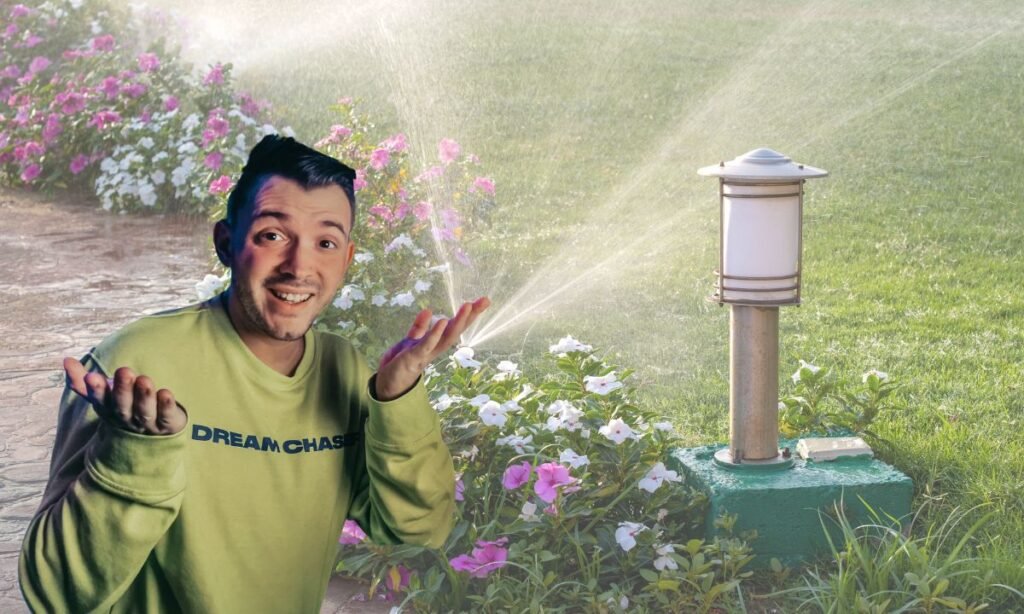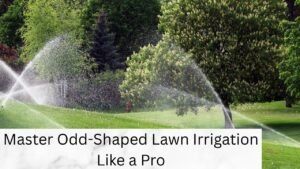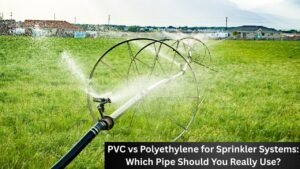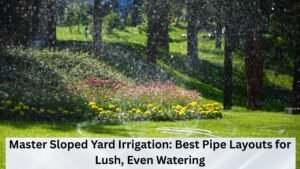Planning your sprinkler system? You need to know one thing before trenching or buying parts: How many sprinklers can run on a single pipe? Skip this — and risk pressure drops, dry spots, or wasted money.
⚡ Quick Answer: How Many Sprinklers Per Pipe?
I cover how pipe size and water flow limit the number of sprinklers you can run without losing pressure. The Youtube video below: How Many Sprinklers per Pipe by Building Sanchalan (YouTube, October 20, 2023) explains the math behind spacing and flow so you can avoid weak sprays and dry patches.
The number of sprinklers you can run depends on your pipe size and water flow.
- ½” pipe: 1–2 pop-up heads
- ¾” pipe: 2–4 rotors or impact heads
- 1” pipe: 4–6 rotors or pop-ups
Make sure your total GPM doesn’t exceed your flow rate or you’ll lose pressure fast.
This is not just a matter of plugging in as many sprinklers as possible. It involves understanding factors like pipe size, water pressure, flow rate, and local conditions. This guide will walk you through the entire process to ensure your sprinkler system is both efficient and effective, particularly if you’re living in Wichita, Kansas.
The Basics: Why Pipe Size Matters

Pipe size directly influences how many sprinklers you can attach to a single line. The size of the pipe determines the volume of water that can flow through it, which in turn affects how many sprinklers can operate effectively without losing pressure.
- 1/2 inch Pipe: Suitable for 1-2 sprinklers, ideal for small areas or drip irrigation systems.
- 3/4 inch Pipe: Supports 2-4 sprinklers, commonly used in average-sized lawns.
- 1 inch Pipe: Can handle 4-6 sprinklers, best for larger lawns or zones requiring more coverage.
Each irrigation pvc size has its own capacity and limitations, and exceeding the number of sprinklers it can handle will result in poor performance, with sprinklers delivering less water than required.
I show why pipe size directly impacts system performance and efficiency. The video below: Pipe Size Matters – How to Read Irrigation Friction Loss Charts by Sprinkler Nerd Andy (YouTube, March 16, 2023) explains how to use friction loss charts so you can size pipes correctly and keep water flowing where it’s needed.
Understanding Water Pressure and Flow Rate
Water pressure is another critical factor. Simply put, it’s the force that pushes water through the pipes and out to your sprinklers. In Wichita, where the average residential water pressure hovers around 40 psi, this should be sufficient for most systems. However, any significant deviation can affect performance.
Measuring Water Pressure:
- Use a pressure gauge: Attach it to an outdoor faucet, turn on the water fully, and take the reading.
- Ideal pressure range: For sprinkler systems, aim for 30-50 psi. Anything above or below may require adjustments or pressure regulation.
Flow rate is the amount of water that passes through the pipe per minute, measured in gallons per minute (GPM). Knowing your flow rate is essential for calculating how many sprinklers your system can support.
How to Measure Flow Rate:
- Perform a bucket test: Fill a container of known volume (like a 5-gallon bucket) and time how long it takes to fill up.
- Calculate GPM: Divide the total gallons by the number of minutes it took to fill the container.
For example, if it takes 1 minute to fill a 5-gallon bucket, your flow rate is 5 GPM.
| Sprinkler Type | GPM Usage | Recommended Pipe Size | Coverage Radius |
|---|---|---|---|
| Pop-Up Head | 1–2 GPM | ½” to ¾” | 10–15 feet |
| Rotor Head | 3–5 GPM | ¾” to 1” | 25–40 feet |
| Impact Sprinkler | 3–4 GPM | ¾” to 1” | 20–35 feet |
Matching Sprinklers to Pipe Size and Flow Rate
Not sure exactly how much water each sprinkler uses? This GPM chart breaks down flow rates by sprinkler type, so you can match heads to your system with precision.
Once you understand your pipe size, water pressure, and flow rate, you can determine how many sprinklers your system can handle. Different sprinkler types have varying water requirements.
Rotary Sprinklers:
- Coverage: Large areas (20-40 feet)
- Water Needs: High flow rate (3-5 GPM per sprinkler)
- Best for: Large lawns or open spaces
Impact Sprinklers:
- Coverage: Medium to large areas
- Water Needs: Moderate to high flow rate (3-4 GPM per sprinkler)
- Best for: Durable and broad coverage
Pop-Up Sprinklers:
- Coverage: Small to medium areas
- Water Needs: Low to moderate flow rate (1-2 GPM per sprinkler)
- Best for: Small lawns, flower beds, or walkways
Sprinkler Quantity per Pipe:
Using your pipe’s size and flow rate, calculate the maximum number of sprinklers you can attach. For instance, if your flow rate is 10 GPM and you’re using pop-up sprinklers that each require 2 GPM, you could theoretically run 5 sprinklers on that line.
💧 Sprinkler Quantity per Pipe (By Pipe Size)
🚿 For ½” Pipe
- Flow Rate: 3–5 GPM
- Supports: 1–2 pop-up sprinklers
- Best For: Flower beds, narrow side yards, small zones
- Note: Avoid rotary heads — pressure will drop quickly.
🚿 For ¾” Pipe
- Flow Rate: 7–10 GPM
- Supports: 2–4 sprinklers (pop-up, impact, or rotary)
- Best For: Medium lawns, front yards, side zones
- Tip: Use pressure-regulated heads for even distribution.
🚿 For 1” Pipe
- Flow Rate: 10–15 GPM
- Supports: 4–6 sprinklers (rotary or pop-up)
- Best For: Large yards, wide open zones, long rows
- Advice: Great choice for systems with multiple zones.
Additional Factors: Soil, Climate, and Lawn Size
Soil type and climate also play significant roles. Wichita’s soil is often clay-based, which can retain water and may require less frequent watering but with longer durations. Conversely, sandy soils drain quickly and might need more frequent watering.
Climate considerations in Wichita include hot, dry summers that increase water demand. You might need more sprinklers to cover larger areas or install drought-resistant plants that require less water.
Lawn size directly affects your sprinkler system design. For larger lawns, you may need to divide your system into multiple zones, each controlled separately to ensure even coverage without exceeding the water supply.
Troubleshooting Common Sprinkler Issues
Even with a well-designed system, issues can arise. Here’s how to address common problems:
- Low Water Pressure: Check for leaks, clean sprinkler heads, and ensure no blockages in the pipes. Adjust or install a pressure regulator if necessary. If problems persist, consider contacting a professional sprinkler repair service in Wichita.
- Uneven Coverage: Realign sprinkler heads and make sure they overlap properly. Consider using different types of sprinklers for varied coverage needs.
- Clogged Sprinklers: Regularly inspect and clean the sprinkler heads. Replace any damaged parts to maintain optimal performance.
Local Considerations for Wichita, Kansas
Wichita’s unique climate and soil conditions necessitate specific adjustments to your sprinkler system. Given the clay-rich soil and periods of drought, it’s important to:
- Optimize watering schedules: Early morning or late evening watering helps reduce evaporation.
- Consider water-saving technologies: Drip irrigation and smart controllers can significantly reduce water use while maintaining a healthy lawn.
- Stay informed: Local regulations on water use, particularly during droughts, may affect how often and how much you can water your lawn.
DIY Tips and Professional Help
For those who enjoy DIY projects, installing or modifying a sprinkler system can be a rewarding challenge. However, complex systems, particularly those involving multiple zones or large properties, might benefit from professional installation.
DIY Installation Tips:
- Plan your layout: Use this GPM chart for all sprinkler types to accurately plan water demands for each zone and avoid under- or over-engineering your layout.
- Install correctly: Follow manufacturer guidelines, especially regarding sprinkler head spacing and depth.
- Regular Maintenance: Perform seasonal checks and winterize your system to prevent damage from freezing.
Conclusion
Determining the correct number of sprinklers per pipe is essential for an efficient and effective irrigation system. By understanding pipe size, water pressure, flow rate, and local factors specific to Wichita, you can create a system that keeps your lawn lush and green throughout the year.
For more complex needs or larger properties, consulting with a local irrigation expert ensures you get the best results.
💬 DIY Pipe & Sprinkler FAQs
Can I use ½” pipe for a full sprinkler zone?
Technically, yes—but it’s not ideal. A ½-inch pipe maxes out around 5 GPM, which supports only 1–2 pop-up heads. For larger zones, you’ll lose pressure fast. Go with ¾” or 1” pipe if you plan to run more than two heads in a zone.
👉 Check out the sprinkler pipe size calculator to dial in your layout.
How many sprinklers can I connect on one garden hose?
It depends on your water pressure and the GPM demand of your sprinklers. Most standard hoses deliver about 5–7 GPM. If your pop-up heads need 2 GPM each, you can safely run 2–3 heads. For rotors, it’s usually just one.
💡 Pro tip: Use a hose-end pressure gauge to test your GPM before connecting.
Do pop-up sprinklers and rotors mix well in the same zone?
Nope, and here’s why: Rotors and pop-ups have different precipitation rates. Rotors apply water slowly (0.5 in/hr), while pop-ups flood faster (1.5 in/hr). Mixing them causes uneven coverage and overwatering.
🛠️ Split them into separate zones for best results.
How far apart should sprinklers be spaced?
A good rule: Head-to-head coverage. That means the spray from one sprinkler should reach the next. For pop-ups, that’s about 10–15 feet. For rotors, plan 25–35 feet.
Can I daisy chain sprinklers together?
You can—but with limits. Daisy chaining works only if you don’t exceed your GPM and pipe friction loss is accounted for. It’s okay for 1–3 heads, but longer chains create pressure drop.
🧮 Use our zone planning calculator to keep things balanced.





